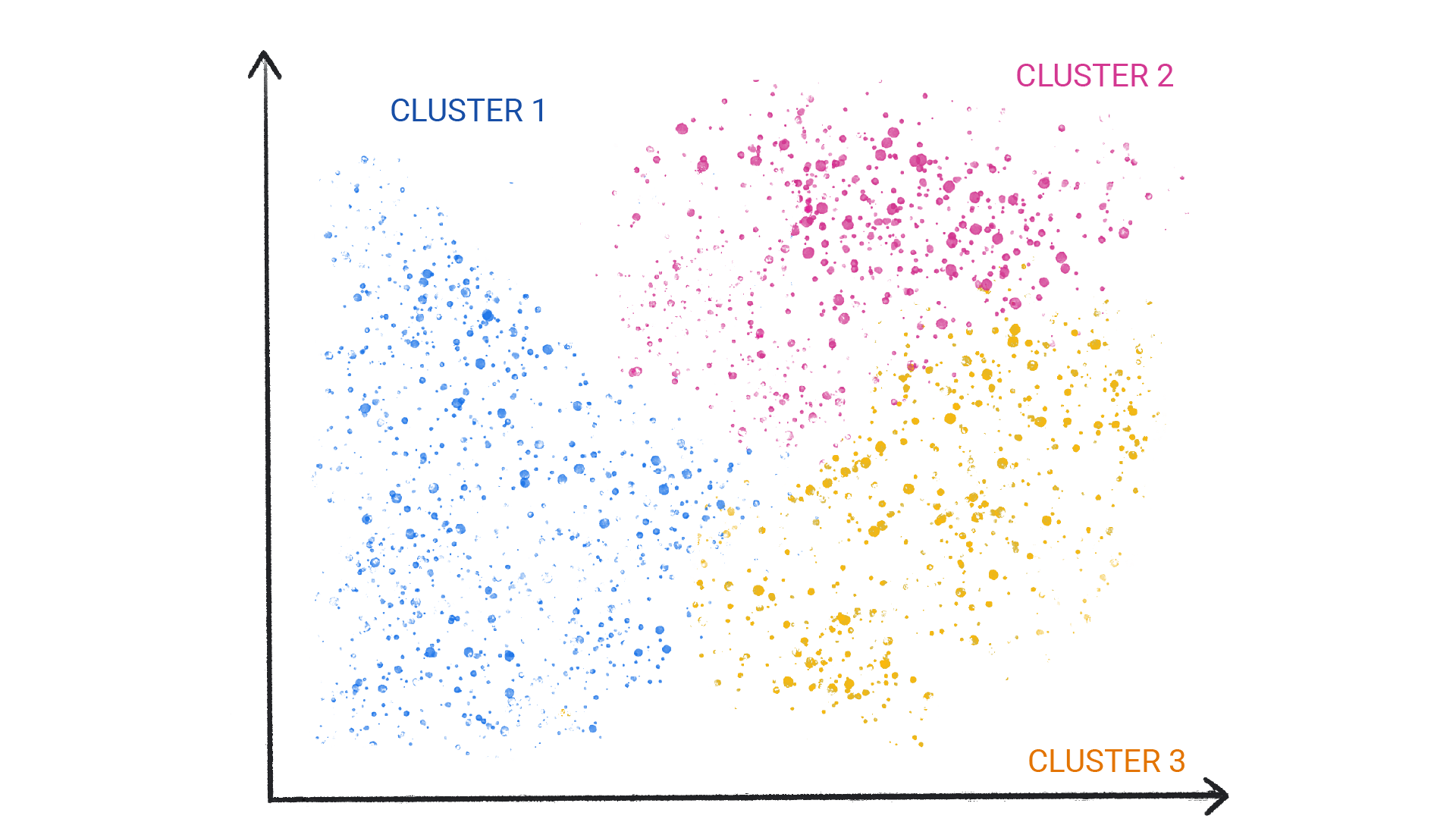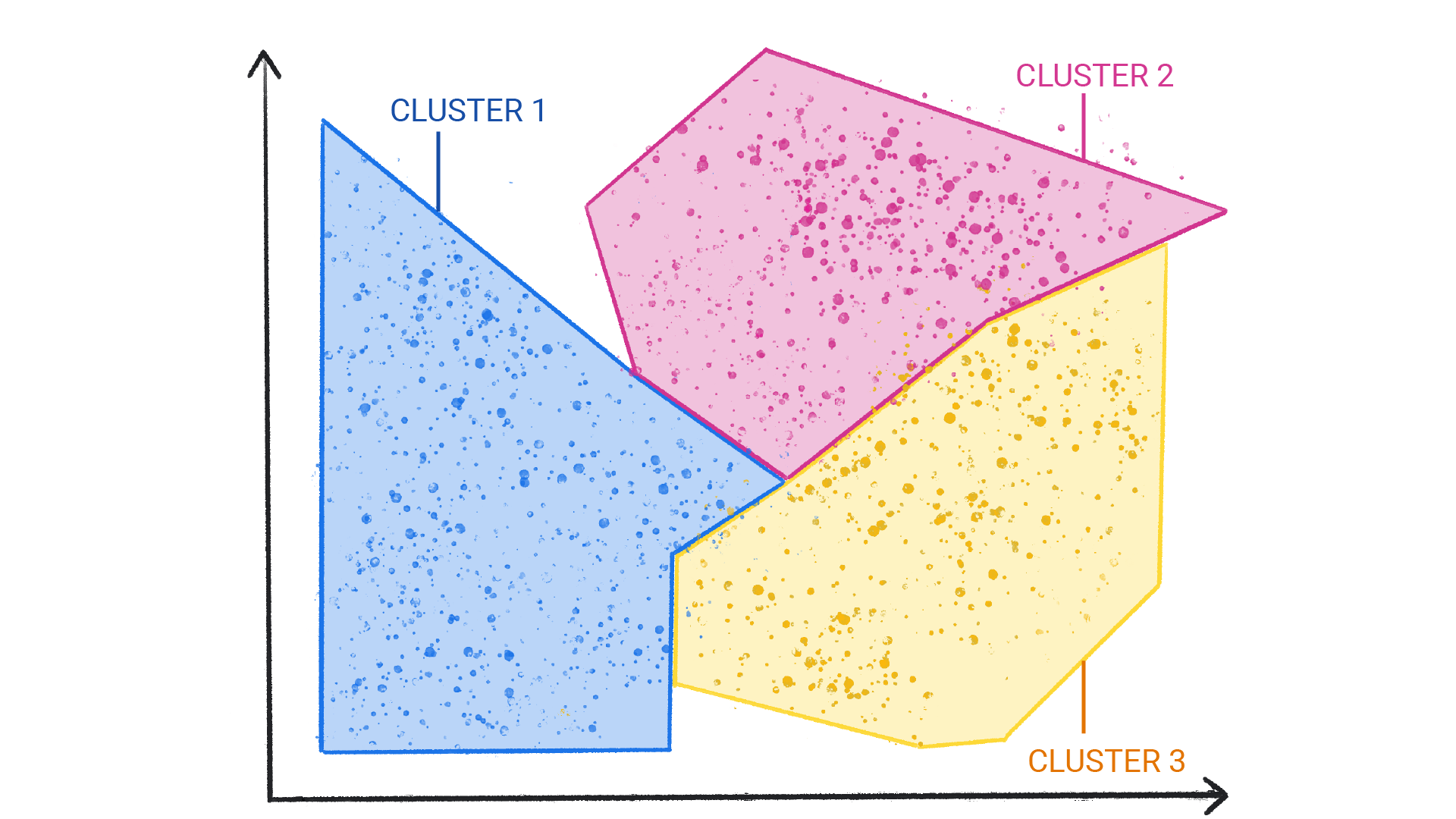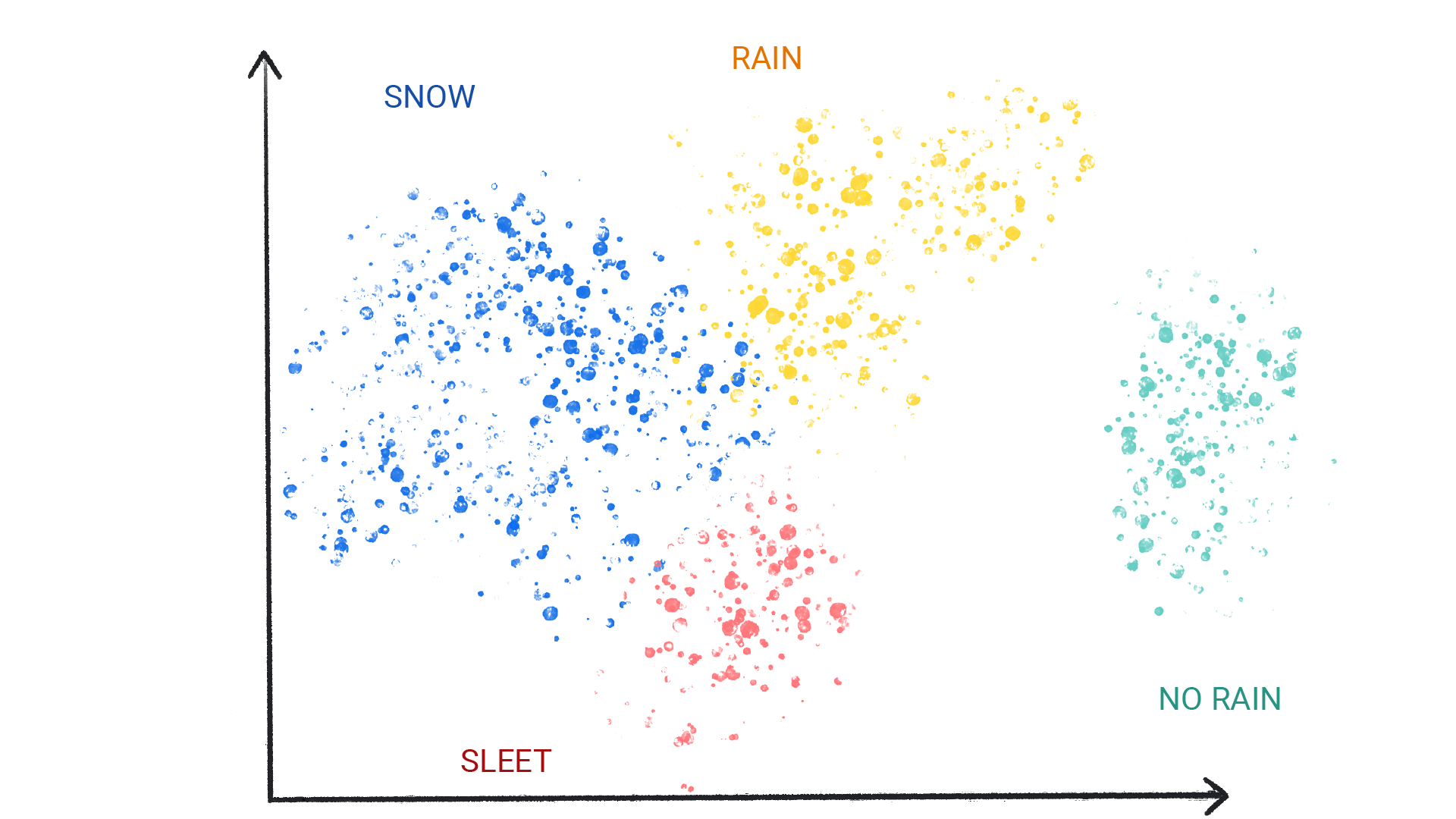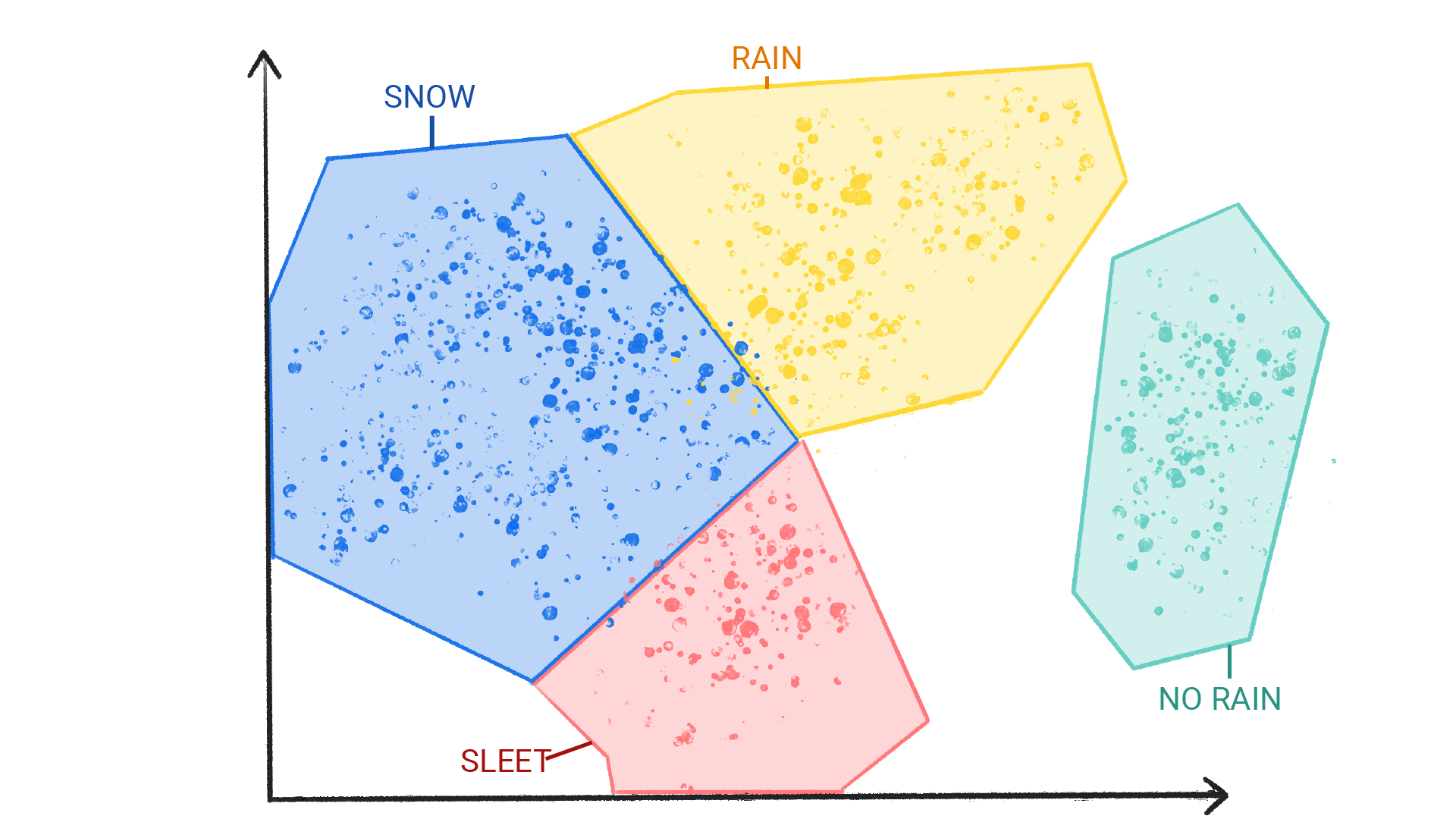Makine öğrenimi (ML), çeviri uygulamalarından sürücüsüz araçlara kadar kullandığımız en önemli teknolojilerden bazılarını destekler. Bu kursta, makine öğreniminin temel kavramları açıklanmaktadır.
ML, sorunları çözmek, karmaşık soruları yanıtlamak ve yeni içerikler oluşturmak için yeni bir yol sunar. Makine öğrenimi; hava durumunu tahmin edebilir, seyahat sürelerini tahmin edebilir, şarkı önerebilir, cümleleri otomatik olarak tamamlayabilir, makaleleri özetleyebilir ve daha önce hiç görülmemiş resimler oluşturabilir.
En basit haliyle makine öğrenimi, model adı verilen bir yazılımı, verilerden yararlanarak faydalı tahminler yapacak veya içerik (ör. metin, resim, ses ya da video) üretecek şekilde eğitme sürecidir.
Örneğin, yağmur yağmasını tahmin eden bir uygulama oluşturmak istediğimizi varsayalım. Geleneksel bir yaklaşım veya makine öğrenimi yaklaşımı kullanabiliriz. Geleneksel bir yaklaşım kullanarak, Dünya atmosferinin ve yüzeyinin fizik tabanlı bir temsilini oluşturur, büyük miktarda akışkanlar dinamiği denklemini hesaplardık. Bu son derece zordur.
Makine öğrenimi yaklaşımını kullanarak, makine öğrenimi modeline büyük miktarlarda hava durumu verisi sağlardık. Bu işlem, makine öğrenimi modeli farklı miktarlarda yağmur üreten hava durumu kalıpları arasındaki matematiksel ilişkiyi öğrenene kadar devam ederdi. Ardından modele mevcut hava durumu verilerini verirdik ve model, yağmur miktarını tahmin ederdi.
Anlayıp anlamadığınızı kontrol etme
ML sistemlerinin türleri
Makine öğrenimi sistemleri, tahmin yapmayı veya içerik oluşturmayı nasıl öğrendiklerine bağlı olarak aşağıdaki kategorilerden birine veya daha fazlasına girer:
- Denetimli öğrenme
- Denetimsiz öğrenme
- Pekiştirmeli öğrenme
- Üretken yapay zeka
Denetimli öğrenme
Denetimli öğrenme modelleri, doğru yanıtları içeren çok sayıda veri gördükten ve ardından verilerdeki doğru yanıtları üreten öğeler arasındaki bağlantıları keşfettikten sonra tahminlerde bulunabilir. Bu, öğrencinin hem soruları hem de cevapları içeren eski sınavları inceleyerek yeni materyaller öğrenmesine benzer. Öğrenci yeterli sayıda eski sınav üzerinde çalıştıktan sonra yeni bir sınava girmeye hazır olur. Bu makine öğrenimi sistemleri, bir insanın makine öğrenimi sistemine doğru sonuçları içeren veriler vermesi anlamında "denetimli"dir.
Gözetimli öğrenmenin en yaygın iki kullanım alanı regresyon ve sınıflandırmadır.
Regresyon
Regresyon modeli sayısal bir değeri tahmin eder. Örneğin, yağmur miktarını inç veya milimetre cinsinden tahmin eden bir hava durumu modeli, regresyon modelidir.
Regresyon modelleriyle ilgili daha fazla örnek için aşağıdaki tabloya bakın:
| Senaryo | Olası giriş verileri | Sayısal tahmin |
|---|---|---|
| Gelecekteki konut fiyatı | Metrekare, posta kodu, yatak odası ve banyo sayısı, arsa büyüklüğü, ipotek faiz oranı, emlak vergisi oranı, inşaat maliyetleri ve bölgedeki satılık ev sayısı. | Evin fiyatı. |
| Gelecekteki yolculuk zamanı | Geçmişteki trafik koşulları (akıllı telefonlardan, trafik sensörlerinden, araç çağırma ve diğer navigasyon uygulamalarından toplanır), hedefe olan mesafe ve hava koşulları. | Bir hedefe ulaşmak için gereken süre (dakika ve saniye cinsinden). |
Sınıflandırma
Sınıflandırma modelleri, bir öğenin bir kategoriye ait olma olasılığını tahmin eder. Çıkışı bir sayı olan regresyon modellerinin aksine, sınıflandırma modelleri bir şeyin belirli bir kategoriye ait olup olmadığını belirten bir değer çıkarır. Örneğin, bir e-postanın spam olup olmadığını veya bir fotoğrafta kedi olup olmadığını tahmin etmek için sınıflandırma modelleri kullanılır.
Sınıflandırma modelleri iki gruba ayrılır: ikili sınıflandırma ve çok sınıflı sınıflandırma. İkili sınıflandırma modelleri, yalnızca iki değer içeren bir sınıftan değer çıkarır. Örneğin, rain veya no rain değerini veren bir model. Çok sınıflı sınıflandırma modelleri, ikiden fazla değer içeren bir sınıftan değer çıkarır. Örneğin, rain, hail, snow veya sleet değerlerinden birini çıkarabilen bir model.
Anlayıp anlamadığınızı kontrol etme
Denetimsiz öğrenme
Denetimsiz öğrenme modelleri, doğru yanıt içermeyen verilerle tahminlerde bulunur. Denetimsiz öğrenme modelinin amacı, veriler arasındaki anlamlı kalıpları belirlemektir. Diğer bir deyişle, modelin her bir veri parçasını nasıl sınıflandıracağıyla ilgili ipuçları yoktur. Bunun yerine, kendi kurallarını çıkarması gerekir.
Sık kullanılan bir gözetimsiz öğrenme modeli, kümeleme adı verilen bir teknik kullanır. Model, doğal gruplamaları belirleyen veri noktalarını bulur.

Şekil 1. Benzer veri noktalarını kümeleyen bir makine öğrenimi modeli.

Şekil 2. Doğal sınırları olan küme grupları.
Kategoriler sizin tarafınızdan tanımlanmadığı için kümeleme, sınıflandırmadan farklıdır. Örneğin, gözetimsiz bir model, hava durumu veri kümesini sıcaklığa göre kümeleyerek mevsimleri tanımlayan segmentasyonları ortaya çıkarabilir. Ardından, veri kümesiyle ilgili anlayışınıza dayanarak bu kümeleri adlandırmaya çalışabilirsiniz.

Şekil 3. Benzer hava durumu modellerini kümeleyen bir makine öğrenimi modeli.

Şekil 4. Kar, sulu kar, yağmur ve yağmur yok olarak etiketlenmiş hava durumu kalıpları kümeleri.
Anlayıp anlamadığınızı kontrol etme
Pekiştirmeli öğrenme
Pekiştirmeli öğrenme modelleri, bir ortamda gerçekleştirilen işlemlere göre ödül veya ceza alarak tahminlerde bulunur. Pekiştirmeli öğrenme sistemi, en fazla ödülü almanın en iyi stratejisini tanımlayan bir politika oluşturur.
Pekiştirmeli öğrenme, robotları bir odada dolaşmak gibi görevleri yerine getirmek üzere eğitmek ve AlphaGo gibi yazılım programlarını Go oyununu oynamak üzere eğitmek için kullanılır.
Üretken yapay zeka
Üretken yapay zeka, kullanıcı girişlerinden içerik oluşturan bir model sınıfıdır. Örneğin, üretken yapay zeka benzersiz resimler, müzik kompozisyonları ve şakalar oluşturabilir, makaleleri özetleyebilir, bir görevin nasıl yapılacağını açıklayabilir veya fotoğrafları düzenleyebilir.
Üretken yapay zeka, çeşitli girişler alıp metin, resim, ses ve video gibi çeşitli çıkışlar oluşturabilir. Ayrıca, bunların kombinasyonlarını da alıp oluşturabilir. Örneğin, bir model giriş olarak resim alıp çıkış olarak resim ve metin oluşturabilir veya giriş olarak resim ve metin alıp çıkış olarak video oluşturabilir.
Üretken modelleri giriş ve çıkışlarına göre ele alabiliriz. Bunlar genellikle "giriş türü" -"çıkış türü" şeklinde yazılır. Örneğin, aşağıda üretken modeller için bazı giriş ve çıkışların kısmi bir listesi verilmiştir:
- Metinden metin üretimi
- Metinden görüntüye
- Metinden videoya
- Metinden koda
- Metin-konuşma
- Resim ve metinden görüntüye dönüştürme
Aşağıdaki tabloda, üretken modellerin, girişlerinin ve olası çıkışlarının örnekleri yer almaktadır:
| Model | Giriş | Örnek çıkış |
|---|---|---|
| Metinden metin üretimi | Le Mans yarışını kim icat etti? |
Le Mans 24 Saat, 1906'da kurulan bir motorlu araç kuruluşu olan Automobile Club de l'Ouest (ACO) tarafından kuruldu. İlk yarış, 26-27 Mayıs 1923'te Fransa'nın Le Mans kasabası yakınlarında bulunan 13,426 kilometrelik (8,345 mil) Sarthe pistinde düzenlendi.
Yarış, başlangıçta ACO ve Sarthe bölgesini tanıtmak için düzenlenmişti. Kaynak: Bard |
| Metinden görüntüye | Uzaylı bir ahtapot, gazete okurken bir portaldan geçiyor. |
 Kaynak: Imagen |
| Metinden videoya | San Francisco'da okyanusta yüzen fotogerçekçi bir oyuncak ayı. Oyuncak ayı suya giriyor. Oyuncak ayı, rengarenk balıklarla birlikte suyun altında yüzmeye devam ediyor. Bir panda su altında yüzüyor. |
 Kaynak: Phenaki |
| Metinden koda | Bir sayı listesinde döngü oluşturup asal sayıları yazdıran bir Python döngüsü yaz. |
for number in numbers: # Check if the number is prime. is_prime = True for i in range(2, number): if number % i == 0: is_prime = False break # If the number is prime, print it. if is_prime: print(number) Kaynak: Bard |
| Resimden metne dönüştürme |  |
Bu bir flamingo. Karayipler'de bulunur. Kaynak: Google DeepMind |
Üretken yapay zeka nasıl çalışır? Üretken modeller, yeni ancak benzer veriler üretmek amacıyla verilerdeki kalıpları öğrenir. Üretken modeller şunlardır:
- İnsanların davranışlarını ve konuşma tarzlarını gözlemleyerek başkalarını taklit etmeyi öğrenen komedyenler
- Belirli bir tarzda çok sayıda tabloyu inceleyerek o tarzda resim yapmayı öğrenen sanatçılar
- Belirli bir müzik grubunun çok sayıda şarkısını dinleyerek o gruba benzemeyi öğrenen cover grupları
Üretken modeller, benzersiz ve yaratıcı çıktılar üretmek için başlangıçta denetimsiz bir yaklaşımla eğitilir. Bu yaklaşımda model, üzerinde eğitildiği verileri taklit etmeyi öğrenir. Model, bazen denetimli veya pekiştirmeli öğrenme kullanılarak, modelden istenebilecek görevlerle (ör. makale özetleme veya fotoğraf düzenleme) ilgili belirli veriler üzerinde daha fazla eğitilir.
Üretken yapay zeka, sürekli yeni kullanım alanları keşfedilen ve hızla gelişen bir teknolojidir. Örneğin, üretken modeller, dikkat dağıtıcı arka planları otomatik olarak kaldırarak veya düşük çözünürlüklü görüntülerin kalitesini artırarak işletmelerin e-ticaret ürün resimlerini iyileştirmesine yardımcı oluyor.
